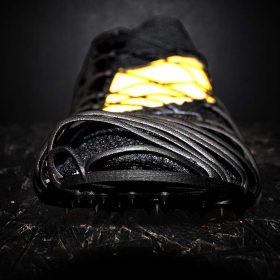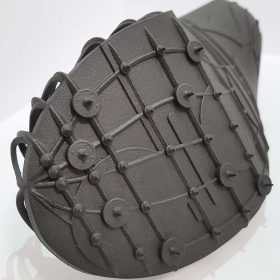Venetian middle-distance runner Miro Buroni, achieving his university studies, decided to combine his two great passions: athletics and design.
Using a completely new and revolutionary concept for the athletics footwear market, he thus developed Pleko, customized athletics track shoes (in jargon, spike shoes) with innovative features in terms of production technology and material.
To create Pleko, Miro made use of the skills and support of two companies, Diadora for historical analysis and design; CRP Technology for the manufacture of the outsole-midsole and ribbing, through professional 3D printing (Powder Bed Fusion process with composite polymers fibers-reinforced, that is Selective Laser Sintering) and Windform® TOP-LINE SLS composite materials.
Process of creation: data to design
Biomechanical analysis and 3D scanning
The creation of Pleko starts with the three-dimensional scan of the athlete’s foot.
This is followed by the biomechanical analysis of the act of running and footing through the 3D foot scan.
The result is a series of mathematical, real data, which are used to create a customized product.
“With this mapping – Buroni comments – we are able to model the shoe on the individual’s needs in terms of foot structure and athletic performance.
Moreover, scanning and biomechanical analysis allow us to understand the best placement of the “traction system” under the outsole, the “pins”.

Study on ribbing
A fundamental requirement of Pleko is the perfect cohesion between the sole-midsole part and the upper part that envelops the foot. This compactness is favored by a series of ribs originated from under the outsole, in correspondence with the lines of maximum effort during the track race. The result is a structure similar to a cage. Its purpose is:
- support the foot to improve running technique
- convey the kinetic energy and minimize its dispersion, ensuring the perfect adherence between the foot and the act of running
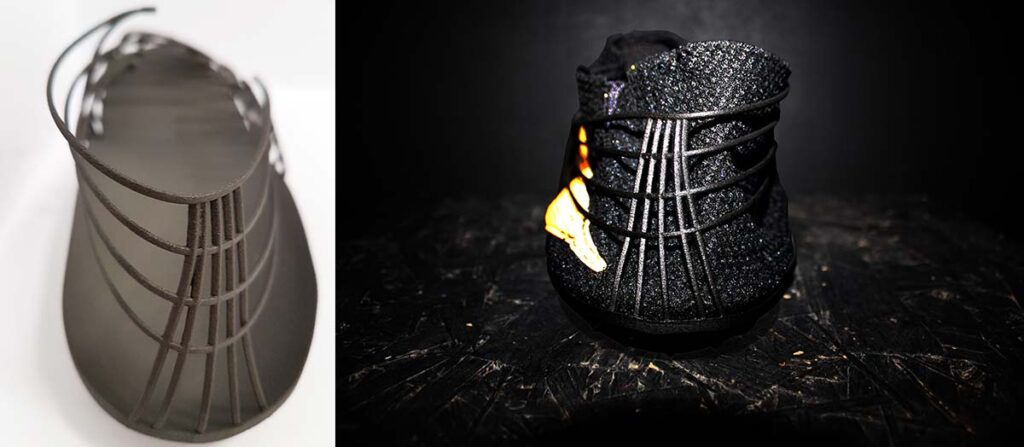
Study on laces
Ribbing is followed by the study on laces.
The correspondence between ribbing/strength trajectories and the adherence produced by the laces, allows a total envelopment of the shoe around the feet.
It may happen that insufficient traction, or the wrong manufacturing material causes energy dispersion. It does not occur with Pleko, that ensures the best kinetic chain.

Manufacture of the outsole, midsole and ribbing
The research of material and manufacturing technology
When the project is ready, Buroni decides to use additive manufacturing to build the supporting structure of the Pleko.
Thus, he focuses on finding a company able to provide professional 3D printing service and a material with “strong characteristics of resistance to bending“.
So, “after a brief research – Buroni adds – it immediately became clear that CRP Technology was the perfect company for my project, and that one of CRP Technology’s top SLS composite materials, Windform® SP, was the ideal solution for me.”
Windform® SP is a Carbon fiber filled composite material for PBF Laser Sintering technology with excellent characteristics of resistance to deformation and flexibility: “the right features for the athletics track shoes.”
Relevance of Windform® SP material
The manufacturing material plays an important role: the results of the investigation on the force transmitted to the track shoes during the track race and the connected requirements, confirmed that the success of the project would depend on the manufacturing material for the outsole, midsole and ribbing.
Just a material with excellent mechanical characteristics would have allowed Buroni to create innovative 3D printed track shoes. This material is Windform® SP.
“Windform® SP – Miro adds – guarantees excellent resistance even in very thin thicknesses; this feature has allowed me to create a spike shoes with a perfect foot envelopment, that facilitates an increase of the comfort and the enhancement of the performance.
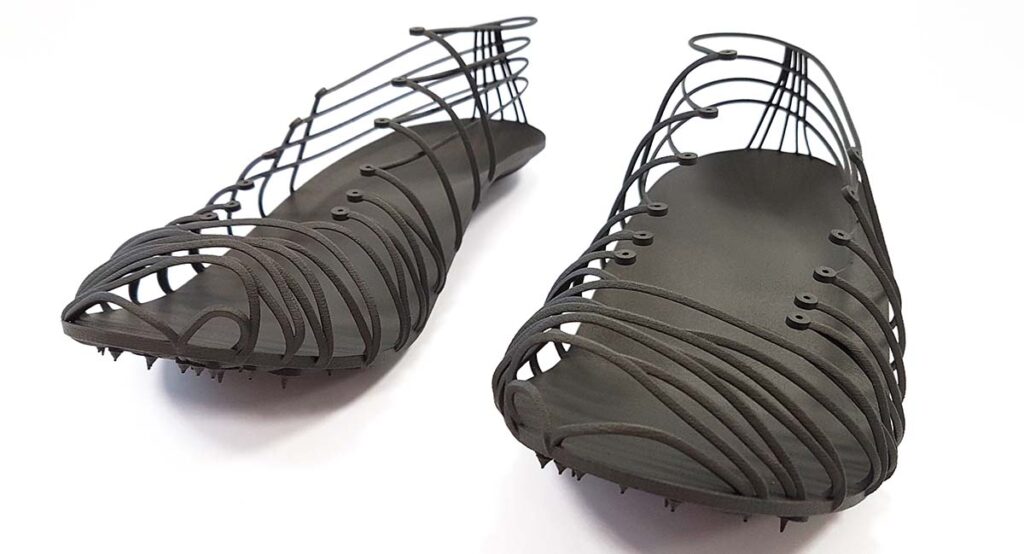
Peculiarities of the 3D printed part in Windform® SP: the ribbing, pins and tiny pins for grip
CRP Technology manufactures as single unit Pleko’s outsole, midsole, ribs – originate from under the outsole – and pins.
Thanks to the ribbing, the structure in Windform® SP embraces the athlete’s foot like a cage, which envelops the foot and facilitate improvements in the running technique. The ribs are responsible for carrying the kinetic energy releases from the biomechanical movement during the track race, and preventing its dispersion.
Buroni specifies: “The spike shoes consist of a sole with midsole and upper. These parts, which are one, under strain become two distinct bodies that generate asynchronous and dissipating movements of the athlete’s kinetic chain. Pleko avoid this occurrence because of the part in Windform® SP, which has inside the sock-like upper, almost completely detached from the structure and responsible for protecting the foot.
“During the track race – Buroni adds – a considerable force is released on the spike shoes, generated by the load produced by the kinetic chain of the athlete’s body.
The pins on the sole let to dissipate minimal force, but the stress on the shoes is maximum. This solicitation is essential to improve running and track race performance.”
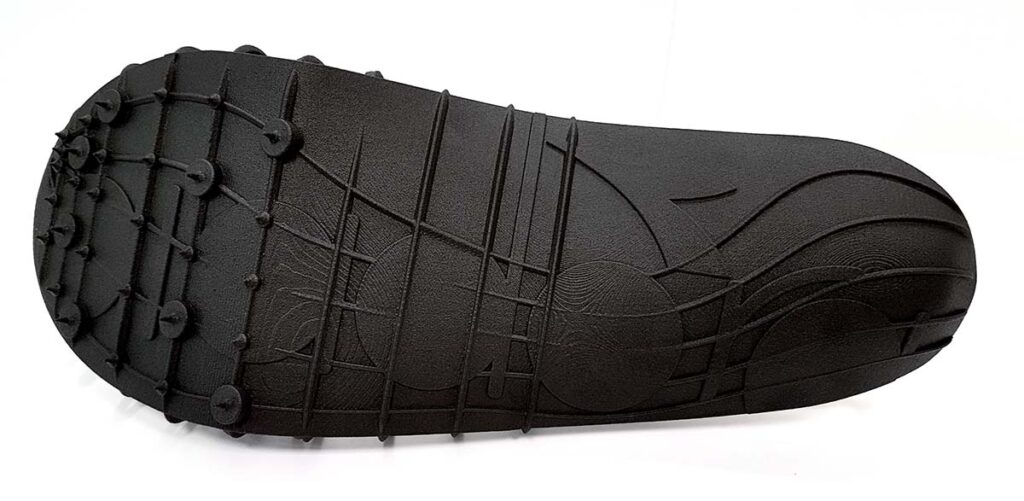
It is therefore clear that the manufacturing material for the structural part of the track shoes must resistant optimally to stress and deformation.
“Thanks to the pins under the outsole – adds Miro – the “cage” in Windform® SP allows the athlete to develop as much strength as possible, without losing energy. I positioned the deepest pins in the points of superior pressure of the feet against the ground. I also put smaller studs in other parts of the outsole: these studs are essential for the stability of the track shoes.”
Once the structural part was 3D printed, other tests were carried out on the Pleko.
Buroni said he was very satisfied with the results achieved: “The design and manufacturing technologies, combined with the Windform® SP and its mechanical characteristics, made the Pleko track shoes highly innovative, taking the design and planning to the highest level of customization and specialization. I am very satisfied with my 3D printed Pleko and Windform® SP.”
Additional benefits: injuries prevention, protection and rehabilitation
The improvement of comfort brings to a new mode to consider and manage injuries prevention, rehabilitation and protection.
Buroni comments: “Thanks to the manufacturing technologies and the Windform® SP, the design of Pleko has been brought to the maximum level of specialization and customization.
Pleko respond to the individual needs of the athlete: they can support rehabilitation activities for a previous injury, but also help to correct an imperfect running, reducing the chances of future injury.”



